Abstract
Recent green manufacturing demands have boosted the development of new biodegradable lubricants to replace petroleum-based lubricants. In this regard, water-based lubricants have been at the vanguard of recent research for a wide range of industrial applications, including metalworking fluids (MWFs). In this work, we present an experimental investigation on the performance of novel green MWFs based on aqueous nopal mucilage solutions. For this, fully biodegradable solutions with different mucilage concentrations (2.29, 4.58, and 6.85 mg/mL) were evaluated in terms of rheological, tribological, thermal stability, and turning (minimum quantity lubrication) performance and compared to a commercial semisynthetic oil-based MWF (Cimstar 60). Mucilage solutions exhibited viscoelastic shear-thinning behavior, which was enhanced along with mucilage concentration. The solution with the highest mucilage content studied resulted in the lowest wear, friction, and temperature in comparison to the other solutions and neat water in extreme pressure four-ball tests and a similar level of lubricity as compared to the commercial MWF in cutting tests. This performance is associated with the enhanced viscosity and elasticity of the solution, as well as the contents of lipids with fatty acids in the mucilage. Overall, the present results reveal the relevance of the viscoelastic behavior of the lubricant, elasticity in particular, in lubrication processes and point to nopal mucilage as an effective green additive to produce innocuous MWFs.
1. Introduction
Water-based lubricants have been at the vanguard of recent research for a wide range of industrial applications due to the abundance and total eco-friendliness of water [1,2]. The idea of using water-based lubricants emerged from the global industry interest in replacing fossil oil-based lubricants with renewable sources (i.e., water or bio-derived oils). Water-based lubricants are blends of water with different chemical species (additives, polymers, stabilizers, nanoparticles, etc.) at low concentrations, either in dispersion or dissolution, to enhance viscosity and lubricity. Water on its own has poor lubricating performance compared to most oil-based lubricants (either fossil- or bio-based); this is due to its low viscosity and propensity to accelerate corrosion. However, considering that water is more sustainable than bio-derived oils, many researchers have explored the inclusion of a wide variety of additives (antioxidants, anti-foaming agents, corrosion inhibitors, detergents, friction modifiers, wear improvers, metal deactivators, and viscosity index improvers) to enhance the performance of water-based lubricants in the last few decades [3,4,5]. Unfortunately, most additives employed in industry are noxious to the environment or human health. More recently, looking for better performance and environmental care, other research groups have studied the addition of different nanoparticles (i.e., TiO2 [6], polyethyleneimine-reduced graphene oxide nanosheets [7], etc.), ionic liquids [8,9], and bio-derived oils to produce water-based lubricants and green emulsions [10,11,12]. The use of bio-derived oils as additives has received increased attention since water-based lubricants in the form of green emulsions are extensively used in the global manufacturing industry as metalworking fluids (MWFs) for lubricating machining, cutting, and removal processes.
Metalworking processes are high energy consumers and have significant environmental effects, as well as severe human occupational health disorders (i.e., cancers, dermatitis, lung disorders, etc.), mainly because of the use of low-performance and highly toxic water-based MWFs [13,14]. Commercial or typical MWFs are emulsions of a fossil or vegetable oil (2–20 wt.%) and a sodium petroleum sulfonate emulsifier (10–15 wt.%) in water. The oil provides the main lubricity properties, the emulsifier allows oil dispersion in water, and water cools down the machining interfaces. It is noteworthy that conventional MWFs are not readily biodegradable and have been reported as one of the most prevalent harmful effluents disposed of in the environment [15]. According to the state-of-the-art of MWFs, the most novel and potential green formulations are those based either on water blended with ionic liquids [16,17], eutectic solvents [18], or bio-oils and green emulsifiers [12]. These three trending technologies are effective but still present different challenges in terms of biodegradability, production costs, and usage conditions.
On the other hand, modern lubricants contain certain amounts of high-molecular weight polymers, as thickeners or viscosity index modifiers, which make them exhibit non-Newtonian rheological behavior [19]. Such a behavior can be simply shear-thinning or more complex viscoelastic. The classical theory of fluid film lubrication is based on Newtonian flow behavior; however, researchers have largely studied the effects of non-Newtonian lubrication (see [20] for an early review on the use of different rheological models). Markedly, in a series of papers, Bair and co-workers analyzed the influence of viscous shear-thinning on film thickness in elastohydrodynamic lubrication (EHL) [21,22,23], with an emphasis on the importance of measuring the piezoviscous behavior of the fluids [24]. This is because EHL occurs at high pressures and shear rates, which can significantly affect the lubricant’s viscous behavior. Fluid elasticity, on the other hand, has received limited attention, despite the fact that lubricants with sufficiently high elasticity may carry greater loads than Newtonian lubricants of similar viscosity [25]. Hutton et al. demonstrated the extra-load carrying capacity of an elastic lubricant in a journal-bearing rig and that this was greater than that predicted by existing theories. Also, the authors showed that the coefficient of friction (CoF) was lower with the viscoelastic lubricant than with a similar Newtonian one [25].
Elasticity of liquid lubricants has been an area of interest to tribologists, but there is yet no consensus on its effect on the thickness of a lubricating film. The reduction in the thickness of a film produced by shear-thinning may mask the effects of elongational viscosity and normal stresses [21]. In fact, in a recent study on hydrodynamic lubrication with shear-thinning and viscoelastic polymer solutions, Veltkamp et al. reported that the fluid’s elasticity does not change friction significantly; meanwhile, shear-thinning affected the lubricant film’s thickness and the dependence of friction on relative velocity in contrast to Newtonian fluids [26]. Thus, in this work, we follow a phenomenological approach to test novel viscoelastic water-based lubricants, namely, aqueous solutions of nopal mucilage, as a MWF. The purpose of this work is two-fold: the first is to evaluate the influence of the elasticity of the mucilage solutions on the turning performance, and the second is to introduce this novel bio-additive (nopal mucilage) as a natural thickener and friction modifier for water to form bio-MWFs.
Nopal cactus, or prickly pear (Opuntia ficus-indica (L.) Mill.), is one of the 1500 species of cactus in the dicotyledonous angiosperm Cactaceae family. It is a tropical and subtropical plant that can grow, either cultivated or wild, in arid and semi-arid climates in different regions of the world. México, Brazil, Peru, Tunisia, and Morocco [27] are among the largest producers of nopal cactus. Nopal has been generally used as human feedstock, and due to its significant contents of nutrients, antioxidants, pectin, polysaccharides, and fibers, it is employed to make health and cosmetic products as well [28,29]. In addition, nopal mucilage is known for its film- and thread-forming capability, which arises from its high molecular weight, resulting in high elasticity. Also, nopal contains lipids or fatty acids [30] with lubricant characteristics, which may make it useful for lubricating purposes.
Briefly, nopal pads or cladodes have multiple channels or conduits in their structure, which are filled with a naturally produced branched high-molecular-weight polysaccharide known as mucilage [31]. This polysaccharide is often considered a hydrocolloid; its structure is proposed as two distinctive water-soluble fractions (pectin with gelling properties with Ca2+ and mucilage without gelling characteristics) [32], so it can be easily dissolved in water. Depending on its molecular weight and concentration, nopal mucilage has the capacity to form aqueous viscoelastic solutions and gels [33], which allows the production of biodegradable, non-toxic, odorless, colorless, and tasteless gels, emulsions, stabilizers, etc. [34]. These characteristics of nopal mucilage, along with its lipid contents, make it a potential thickening agent/additive for producing water-based lubricants. Notably, using nopal mucilage as an additive for producing green MWFs has not been reported before.
In this work, solutions with different mucilage concentrations (2.29, 4.58, and 6.85 mg/mL) were characterized in terms of the most critical MWFs’ properties, such as rheological and tribological properties, thermal stability, and turning performance, and compared to a commercial MWF. Overall, the results of this work indicate that the elasticity of nopal mucilage solutions and the lipids contained in the mucilage resulted in reduced friction and wear, with the solution with the highest mucilage concentration being similar to the commercial MWF. Finally, the results of this work suggest that viscoelastic aqueous nopal mucilage-based solutions can be safely used as green MWFs for turning operations under minimum quantity lubrication (MQL) conditions.
2. Materials and Methods
2.1. Preparation of Fluid Samples
The nopal mucilage utilized in this work was obtained from nopal flour (Droguería Cosmopolita, Mexico City, Mexico) by the separation process described next. The nopal flour was used as received, and according to the supplier, it was obtained through lyophilization by following the procedure reported elsewhere [35]. In such a procedure, the flour is obtained from nopal cladodes with lengths between 18 and 30 cm, which, according to Mexican and international standards, are typical sizes of young cladodes. The cladodes are first washed and the thorns removed; then, the cladodes are sliced into small pieces and frozen (−10 °C) to dry by freeze-drying. Finally, the dried product is finely crushed to obtain the nopal flour. To obtain the mucilage in this work first, 50 g of nopal flour were dispersed into 900 mL of tridistilled water (Reactivos Química Meyer, Mexico City, Mexico) by stirring at 500 rpm with a marine-type propeller coupled to a mechanical stirrer (BDC 2002, Caframo, Georgian Bluffs, ON, Canada). During dispersion, the temperature was maintained at 45 ± 2 °C using a stirrer hot plate mixer (PC320, Corning Life Sciences, Corning, NY, USA). The temperature of the dispersion was monitored continuously with a thermometer. After one hour of stirring, 0.1 g of the antioxidant ascorbic acid (Droguería Cosmopolita) was added to the suspension while keeping the agitation for an additional 30 min. Next, 0.6 g of benzoic acid (Droguería Cosmopolita) was added as a preservative to inhibit the growth of microorganisms. After continuous agitation for 2 h, the as-obtained suspension was filtered using nylon meshes to remove insoluble compounds such as fibers and cellulose particles. The filtration system consisted of a ceramic Büchner funnel with nylon meshes of apertures 600, 300, 150, 104, 80, and 48 μm, respectively, a 1000 mL Kitasato flask, and a vacuum pump (Siemens, Munich, Germany), whose maximum vacuum pressure was 65 cm-Hg. The obtained filtered solution contains mainly mucilage and small amounts of fine particles of cellulose and water-soluble compounds, with mucilage being responsible for the viscoelastic behavior of this type of fluid [33].
The filtered nopal solution was placed in a volumetric flask, and the volume was adjusted to 1000 mL. This primal nopal mucilage solution was identified as “S3”, and dilutions were prepared with 1:2 (solution “S2”) and 2:1 (solution “S1”) parts of water and primal solution in a volumetric flask of 250 mL. The concentration of mucilage in each solution was determined by freeze-drying (lyophilization). For this, 100 mL of the S1 solution were placed in a lyophilization vessel, frozen at −10 °C, and then introduced into a LABCONCO FreeZone 6 lyophilizer. Freeze drying was carried out for eight hours/day for three days at a vacuum pressure of 7 × 10−3 mBar and a temperature of −25 °C. At the end of each day, the vessel was placed in a freezer to continue the process the next day. It was determined that 100 mL of S1 contained 0.229 g of solids, giving a concentration of 2.29 mg/mL of mucilage. From this, the concentrations of the S2 and S3 dispersions were 4.58 and 6.85 mg/mL, respectively. Following this procedure, approximately 138 g of mucilage were obtained from an initial mass of 1000 g of commercial nopal flour, giving a yield of 13.8%.
For comparison, a commercial cutting fluid (Cimstar 60 (CIMCOOL® Industrial Products LLC, Columbus, OH, USA)) was prepared as typically used in industry, namely, at a 10 wt.% concentration in tap water. The Cimstar 60 is a semisynthetic oil-based cutting fluid, specially formulated with extreme pressure lubricating agents, used in the manufacturing process as a cutting fluid and grinding or metal-forming fluid. In addition, due to its complex formulation, it confers lubricity properties and corrosion protection while reducing foaming. The mucilage solutions (S1, S2, and S3) and the commercial cutting fluid (Cimstar 60) were characterized and compared by rheometry, tribology, thermogravimetric analysis, and turning tests, as described below.
2.2. Determination of the Weight-Average Molecular Weight (MW) of the Mucilage
The molecular weight (MW) of macromolecules is one of the main parameters determining the rheological behavior of their solutions; the higher the MW, the more viscoelastic the solution. The MW of the mucilage utilized in this work was determined with the S3 solution by static light scattering (SLS) using an Abbemat 550 refractometer (Anton Paar, Graz, Austria) and a LiteSizer 500 device (Anton Paar). Full details of the procedure for MW determination may be found elsewhere [33]. The measurements resulted in MW = 3.618 × 106 g/mol, which is consistent with the molecular weight measured for mucilage from young nopal pads (~100 days old) [33].
2.3. Rheological Testing of the Fluids
The three aforementioned nopal mucilage solutions and the Cimstar 60 cutting fluid were characterized by rheometrical experiments using a stress-controlled rotational rheometer (MCR 302, Anton Paar) and shear rate ramps. These were conducted in the range of 0.5 to 500 s−1 for the nopal mucilage solutions using a standard concentric cylinder flow geometry (Rinner = 13.33 mm, Router = 14.563 mm, and L = 40 mm). In addition, a cone and plate geometry with D = 50 mm and an angle of 2° was used to measure the first normal stress difference (N1) of the solutions. Due to its lower viscosity, as compared to the mucilage solutions, the Cimstar 60 fluid was characterized in the range of 1 to 100 s−1 using a double-gap flow geometry (R1 = 11.914 mm, R2 = 12.324 mm, R3 = 13.331 mm, R4 = 13.795, and L = 40 mm), which was intended to test very low-viscosity samples. In each case, the flow geometry and fluid temperature were controlled at 25 ± 0.01 °C by using a Peltier system with a platinum thermocouple (type S). Flow experiments were performed in triplicate to ensure reproducibility.
2.4. Tribological Testing
The extreme pressure, tribological, and lubricity properties of the mucilage solutions were obtained by conducting ASTM D4172 standard four-ball tests [36] under the conditions presented in Table 1. A schematic view of the test set-up can be seen in Figure 1. The four-ball test consists of rotating an AISI 52100 steel ball against three other similar stationary balls immersed in the fluid sample under a specified load, speed, temperature, and time. The coefficient of friction (CoF) and fluid temperature changes were measured by the tester. To compare the performance of mucilage solutions as cutting fluids, these and pure water (type 1), as well as the Cimstar 60 fluid, were tested under the same conditions. All the tests were initiated at room temperature (25 ± 1 °C). Since fluid temperature rises due to friction during the tribological test, each test was stopped either until it reached a maximum test time of 35 min or once the fluid temperature reached 100 °C; this was performed to avoid fluid evaporation and ball welding. The CoF was monitored during the whole test and then averaged for further analysis. After finishing each test, the wear scar diameter (WSD) generated in the three lower balls was measured by optical microscopy and then averaged. In order to compare the wear performance of each fluid, the WSD per unit time was calculated by dividing the mean WSD by each corresponding test time.

Table 1.
Tribological testing parameters.
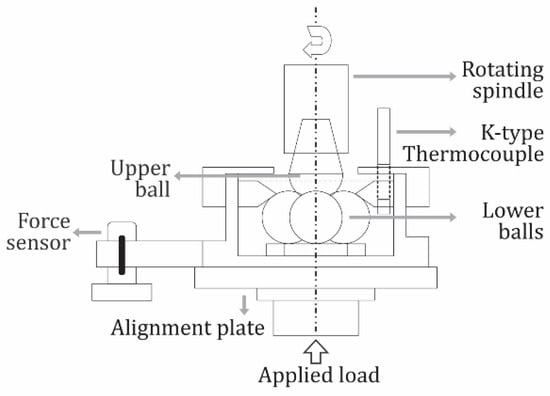
Figure 1.
Tribological (four-ball) test set-up (ASTM D4172).
2.5. Turning Test
The performance of the mucilage solutions as the cutting fluid was assessed in actual turning processes under minimum quantity lubrication (MQL) conditions, following the methodology schematically represented in Figure 2. Dry cutting tests as well as lubricated cutting tests with pure water (type 1), Cimstar 60, and the mucilage solutions were also conducted for comparison purposes. The reason for selecting MQL is that it is nowadays considered one of the greenest lubrication and cooling techniques for cutting processes [37], as well as due to the fact that it requires much smaller amounts of fluid samples for testing in comparison to flood lubrication. In addition, using small amounts of fluid was convenient for this first experimental approach. It must be said, however, that the studied solutions may well be used in flood lubrication. MQL consists of applying the minimum dose of MWF required to lubricate and cool down the workpiece and cutting tool interface along with an air-assisted jet (tiny droplets of MWF are dispersed in the air jet at high speed and applied to the cutting interface) [12]. The cutting tests were performed on a 5.5 HP lathe (Pinacho SP 200) under the lubrication and cutting parameters given in Table 2. These MQL parameters were set on the basis of the cutting tool supplier’s recommendations for steel finishing operations. Steel (AISI 1018) was selected to prepare the workpieces since it is a relatively hard (116 HB) and common material. For each test, a new coated carbide insert was used as a cutting tool. The cutting performance of the fluids was determined by analyzing cutting forces (Fz), which can be related to energy consumption, workpiece finishing (in terms of surface roughness, Ra), and cutting interface temperature. Fz values were measured during the machining operation using a piezo-electric dynamometer (Kistler type 9121), a dual-mode amplifier (Kistler type 5814B1), and a data acquisition device (NI-USB 6008). The resulting surface finishing of the workpieces was evaluated by measuring roughness (Ra) using a contact profilometer (Surfcom 130A) by taking the average of three roughness readings along the longitudinal direction with a 120° offset. The cutting interface temperature was monitored using a thermal image camera (FLIR TG 165) during the entire test. The temperature change was determined as the difference between the cutting interface temperature before and after the test.
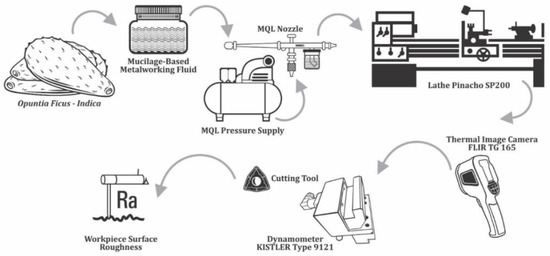
Figure 2.
A schematic representation of the cutting performance test methodology.

Table 2.
Metal cutting test parameters.
2.6. Thermal Stability Analysis
The thermal stability of nopal mucilage solutions and the Cimstar 60 was investigated by thermogravimetric analysis using TGA (STAi 1000, Instruments Specialists Incorporated) from 30 to 200 °C using a temperature ramp of 10 °C/min and a nitrogen atmosphere. Thermal stability indicates thermal resistance and thermal degradation during the use of MWFs. For this, the samples were placed in platinum pans, and the weight change was determined using a balance with 0.1 μg of resolution. At the same time, the temperature was measured with a type R thermocouple with a resolution of 0.1 °C.
3. Results and Discussion
3.1. Rheological Behavior of Nopal Mucilage Solutions and Cutting Fluid
The shear viscosity as a function of the shear rate for the mucilage solutions and Cimstar 60 fluid is presented in Figure 3, which also includes the first normal stress difference measured as a function of the shear rate for the S3 solution. First, it can be seen that mucilage solutions behave as non-Newtonian shear-thinning fluids and that their viscosity increases with increasing mucilage concentration. Also, the shear-thinning behavior is more marked for higher mucilage concentrations and can be well fitted by the Cross model (continuous lines in Figure 3) given by [33]:
where and are the viscosity values at zero and infinite shear rate, , respectively, and and are the other fitting parameters of the Cross model reported in Table 3. Another shear-thinning model that covers similar flow regimes, i.e., Newtonian plateaus in the low and high shear rate regions with a shear-thinning intermediate one, is the Carreau model, which has been used for calculations of the film thickness in different lubrication situations [22,38]. It is noteworthy that both mentioned rheological models are purely shear-thinning, so they do not consider the elastic behavior of the fluids. In this regard, only solution S3 exhibited measurable elasticity or normal stresses (N1), which scale in a power-law fashion with the shear rate:
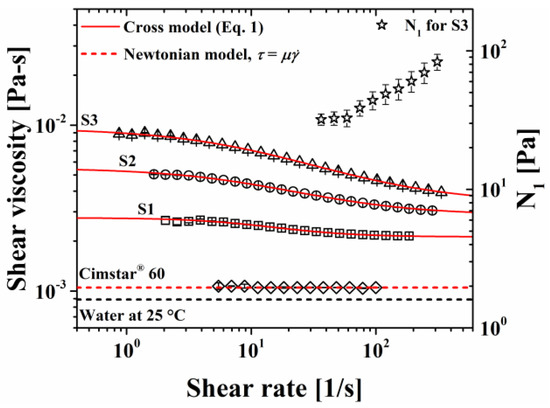
Figure 3.
Shear viscosity of the nopal mucilage solutions and the cutting fluid as a function of shear rate, and N1 versus shear rate for S3. Continuous lines indicate the fitting of the shear viscosity of nopal mucilage solutions to the Cross model, while the dotted line indicates the fitting of the cutting fluid to the Newtonian model, where τ is the shear stress and μ denotes the viscosity.

Table 3.
Cross model parameters for nopal mucilage solutions.
Even though the dependence of on the shear rate is not very strong, Equation (2) indicates that the elasticity of S3, which may be seen as a lifting effect [39,40], increases with the shear rate and may become significant under the very high shear rates (>106) found in lubrication. For the studied system, both the thickening effect of mucilage macromolecules and the elasticity of their solutions depend on their MW and concentration in solution; the greater these values, the more pronounced the effects. On the other hand, MW depends on the age of the cladodes; the older the cladode, the higher the value of MW [33]. The MW calculated in this work for the obtained mucilage was 3.618 × 106 g/mol, which is consistent with that of young cladodes (~50–100 days old) [33] and with the method of selection to produce commercial nopal flour [35]. In this respect, older nopal cladodes (>one year old), which, in general, have less practical use because of their high content of fiber and minerals [30], could be exploited to obtain highly elastic and thickening mucilage.
On the other hand, the Cimstar 60 fluid (Figure 3) exhibits a purely viscous Newtonian behavior (i.e., constant viscosity without elasticity), as is the case for most conventional and commercial MWFs, due to their main content of mineral or synthetic oil. It also exhibits lower viscosity than the three mucilage solutions for similar shear rates.
3.2. Tribological Properties
Figure 4a–c show the tribological behavior of the mucilage solutions in terms of WSD per unit time, CoF, and the final fluid temperature reached in the four-ball test. The error bars represent the standard deviation obtained from four test repeats. The temperature of the fluid rises because of friction through the test and the fluid’s thermal properties. According to Figure 4c, Cimstar 60 was the only fluid that resisted for 35 min without reaching 100 °C. The rest of the fluids reached 100 °C before 35 min of testing. Water (type 1) reached 100 °C after only 3 min, while S1, S2, and S3 reached this temperature after 10, 19, and 25 min of testing, respectively. This behavior is ascribed to the CoF behavior produced by each fluid, as shown in Figure 4b and Figure 5; the larger the CoF, the higher the temperature and the lower the testing time. Following the tribological tests, the mean WSD was measured and divided by each corresponding test time in order to obtain the WSD per unit of time, which is reported in Figure 4a. This is useful to compare the wear caused by the different fluids. Water (type 1) exhibited the largest WSD per unit time, while Cimstar 60 exhibited the lowest. According to the WSD per unit time results of the mucilage-based fluids, S1 exhibited the largest WSD, while S3 exhibited the lowest. This means that increasing the content of mucilage in the solutions helps to reduce CoF and wear, which is associated with the increase in viscosity and elasticity, as well as the thermal stability that the mucilage provides to water for longer periods of time. Also, it is noteworthy that the CoF of Cimstar 60 and S3 are comparable, being overall lower for S3, meaning that this concentration of mucilage is able to produce a similar level of lubricity as the commercial semisynthetic oil-based cutting fluid under extreme pressure conditions.

Figure 4.
Tribological results of the nopal mucilage solutions and the cutting fluid in terms of: (a) WSD per unit time (µm/s); (b) CoF; and (c) final fluid temperature (°C). The t-values in (c) represent the duration of the test for each fluid.
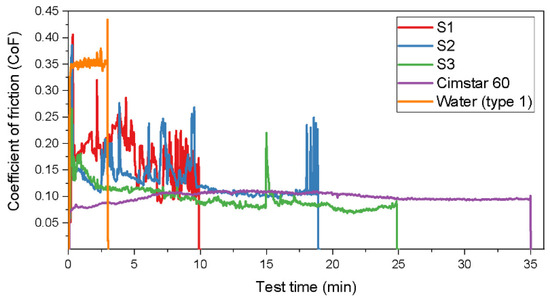
Figure 5.
CoF evolution during lubrication with the nopal mucilage solutions and the cutting fluid.
On the other hand, although it is well known that the viscosity of the lubricant is the main contributor to maintaining the lubricating film thickness, the elasticity [38], and the presence of lipids with saturated fatty acids (SFAs) and monounsaturated fatty acids (MUFAs) in the mucilage in solution [41,42] may also contribute to improving lubricity. Depending on the age of the cladodes, the extracted mucilage can contain between 2.3 and 4.4 g 100 g−1 of lipids (with different fatty acids, including SFAs and MUFAs), with these decreasing with increasing cladodes age [43]. For similar young cladodes (~100 days old), the lipid content has been measured at ~4 wt.%, so these lipids may be acting synergistically with the viscoelastic properties of the mucilage solutions to produce good lubricating properties.
3.3. Turning Performance
Figure 6 shows the cutting forces for the dry and MQL conditions using all the fluid samples. The cutting force represents the force required for cutting the workpiece (metal bar) in turning; the lowest cutting force has the best MWF performance and the lowest energy consumption. As expected, the highest and lowest cutting forces were measured under dry conditions (force about 155 N) and when Cimstar 60 (force about 113 N), respectively. In the case of the mucilage solutions, the cutting force shows a slight but systematic decrease with the mucilage content as compared to water (type 1), with S3 exhibiting the lowest force (about 120 N). This result is ascribed to the higher viscosity and shear-thinning behavior of S3 (see Figure 3), which allows it to remain longer in the cutting region, as well as to the low CoF produced due to the fatty acid content and elasticity of this solution (see Figure 4b).
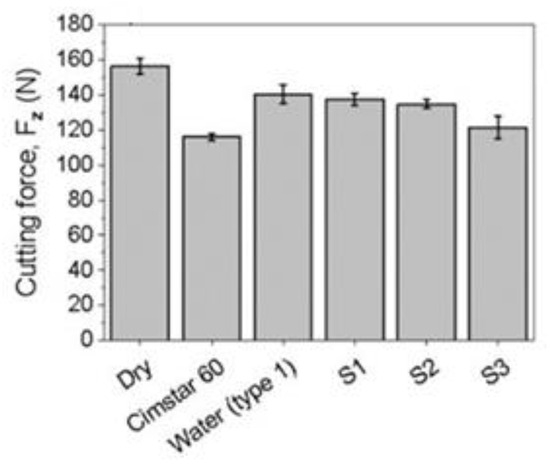
Figure 6.
Cutting forces generated by the nopal mucilage solutions and the cutting fluid under dry and MQL conditions.
The obtained quality of the surface finish (surface roughness, Ra) after the cutting process and the increase in temperature (ΔT) at the cutting interface are shown in Figure 7a,b, respectively. It was found that all the fluids tested generated similar workpiece surface quality/roughness (around 4 µm, Ra). and it was about 35% lower than that produced under dry conditions, as shown in Figure 7a. Moreover, Cimstar 60, S2, and S3 presented the lowest reduction (about −1.8 °C) in cutting interface temperature, as shown in Figure 7b, which means that these fluids promoted a similar cooling performance.
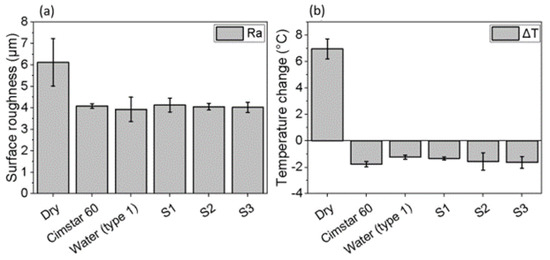
Figure 7.
(a) Surface roughness (Ra, µm) and (b) temperature change (Δ °C) at the cutting interface obtained by using the nopal mucilage solutions and the cutting fluid.
3.4. Thermal Stability
The thermogravimetric analysis results of the nopal mucilage solutions and Cimstar 60 fluid are shown in Figure 8. It can be seen that, in the analyzed temperature range, the most stable fluid was Cimstar 60, followed by the nopal mucilage solutions and water, the last completely evaporating at 95 °C. The Cimstar 60 fluid exhibited a weight loss of 44% at 107 °C, while the same value was observed for S3 at 97 °C, S2 at 96 °C, and S1 at 94 °C. For water, the same weight loss was observed at 76 °C. On the other hand, the Cimstar 60 fluid exhibited thermal instability in the range of 107 to 126 °C, as evidenced by oscillations of weight loss and a rapid change from 44 to 95%. This thermal instability may be attributed to the breakage of the emulsion induced by the thermal degradation of the lipophilic phase and the rapid evaporation of water. On the other hand, the nopal mucilage solutions evaporate entirely in the range from 113 to 119 °C, with the higher evaporation temperature for the most concentrated solution, S3, being 23 °C higher than pure water and 7 °C lower than Cimstar 60 fluid. Thus, the thermogravimetric analysis indicates that if the working temperature of the metalworking application is below 100 °C, the nopal mucilage solutions could be used as MWF safely since their thermal performance is comparable to that of commercial cutting fluid (Cimstar 60) in this temperature range. Should it be necessary to enhance even more the thermal stability of nopal solutions, this may be achieved, for example, by adding nanoparticles, as functionalized graphene nanoplatelets [44], nano ZrO2 [45], or other additives for synthetic base oils.
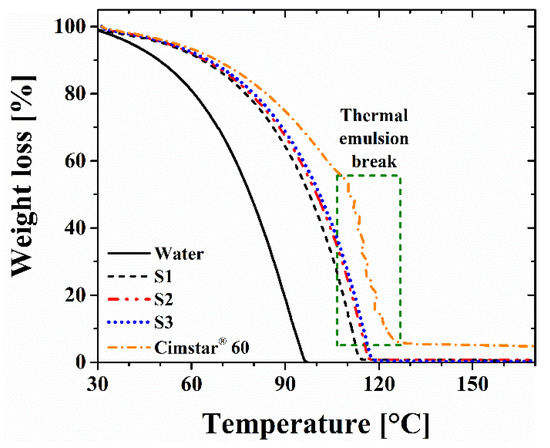
Figure 8.
Thermogravimetric analysis of the nopal mucilage solutions and the cutting fluid.
In summary, the results obtained from rheology, tribology, thermal stability, and turning tests suggest that mucilage-based viscoelastic solutions exhibit good characteristics to be used as conventional cutting fluids for MQL operations. In particular, S3 (the solution with the highest mucilage content) showed the most pronounced viscoelastic behavior and similar performance to the commercial MWF (Cimstar 60), which reveals the influence of the fatty acid composition of the mucilage and the elastic behavior of the solution in this lubrication process. In addition, considering the facts that mucilage solutions were produced by green chemistry methods using sustainable raw materials (water and nopal mucilage) and are innocuous and totally biodegradable, mucilage viscoelastic solutions represent potential alternative MWFs for industrial applications meeting the current global stringent demands of green manufacturing [12,15]. To conclude, a comment is pertinent regarding the cost of production of the S3 solution as compared to the commercial MWF. In this first approach to producing the solution, the estimated cost considering energy consumption and raw materials is 20 USD/kg, which can be used to prepare 145.77 L of S3. Then the estimated cost of S3 is 0.14 USD/L, which is significantly lower than the commercial MWF (1.2 USD/L). Clearly, optimization of the process may decrease the costs even further.
Finally, apart from the cutting/turning processes analyzed in this work, these kinds of solutions need to be further evaluated to demonstrate their effectiveness in other types of cutting operations such as drilling, milling, etc., including longer cutting operations and tool wear analysis. Also, a more systematic and mechanistic evaluation of the isolated effect of the elasticity of viscoelastic fluids on the tribological and metal cutting performance is necessary; this is a topic of ongoing research in our group.
4. Conclusions
The main conclusions derived from this work can be summarized as follows:
- Three solutions of water with different concentrations (2.29, 4.58, and 6.85 mg/mL) of nopal mucilage and 0.6 g of benzoic acid, as a preservative to inhibit the growth of microorganisms, were effectively produced through green chemistry techniques.
- Mucilage solutions were found to behave as non-Newtonian shear-thinning fluids, whose viscosity increases with increasing mucilage concentration. On the other hand, the reference MWF (Cimstar 60) exhibited a Newtonian viscous behavior with a lower viscosity than the mucilage solutions.
- The solution with the highest mucilage content exhibited, in addition, viscoelastic behavior, which resulted in the lowest wear, friction, and temperature in comparison to the other solutions and neat water in the extreme pressure four-ball tests. This is associated with the viscosity and elasticity of mucilage solutions. Additionally, the solution with the highest concentration of mucilage was able to produce a similar level of lubricity as compared to the commercial semisynthetic oil-based MWF, which was attributed to the viscoelastic behavior and content of lipids with fatty acids in the mucilage. These results provide insight into the relevance of the viscoelastic behavior of the lubricant, elasticity in particular, in the lubrication process, an influence that deserves further attention.
- According to the metal cutting tests, the cutting force decreased significantly when using the fluid having the highest mucilage content, which is associated with both the increase in viscosity and decrease of CoF promoted by the mucilage content and viscoelastic behavior in this solution. Also, it was found that the three solutions generated similar workpiece surface quality/roughness (around 4µm, Ra) and interface cool-down than that produced by Cimstar 60.
- The thermogravimetric analysis indicated that the nopal mucilage solutions could be safely used as MWF below 100 °C since their thermal performance is comparable that of commercial cutting fluid (Cimstar 60) at these temperatures.
- Finally, it was demonstrated that the solution with the highest mucilage content presented similar lubricating effects to those of a commercial semisynthetic oil-based cutting fluid (Cimstar 60), making it a potential innocuous green cutting fluid for MQL operations.
Author Contributions
L.I.F.-C.: Conceptualization; investigation; writing—original draft preparation; writing—review and editing; formal analysis; project administration. O.A.A.-R.: investigation; writing—original draft preparation; data curation. J.P.-G.: conceptualization; investigation; writing—review and editing; formal analysis; project administration. B.M.M.-S.: investigation; writing—review and editing; data curation. F.R.-G.: investigation; writing—review and editing; data curation. All authors have read and agreed to the published version of the manuscript.
Funding
This research received no external funding.
Data Availability Statement
Data are contained within the article.
Acknowledgments
Oscar A. Aguilar-Rosas would like to thank the Mexican National Council of Humanities, Science, and Technology (CONAHCYT) and Tecnologico de Monterrey for the scholarships they received for conducting a part of this research project.
Conflicts of Interest
The authors declare no conflicts of interest.
References
- Zhou, S.-S.; Song, J.-J.; Xu, P.; He, M.; Xu, M.-B.; You, F.-C. A Review on Tribology Characterization and Lubricants for Water-Based Drilling Fluids. Geoenergy Sci. Eng. 2023, 229, 212074. [Google Scholar] [CrossRef]
- Rahman, M.H.; Warneke, H.; Webbert, H.; Rodriguez, J.; Austin, E.; Tokunaga, K.; Rajak, D.K.; Menezes, P.L. Water-based lubricants: Development, properties, and performances. Lubricants 2021, 9, 73. [Google Scholar] [CrossRef]
- Menezes, P.L.; Ingole, S.P.; Nosonovsky, M.; Kailas, S.V.; Lovell, M.R. Tribology for Scientists and Engineers; Springer: New York, NY, USA, 2013. [Google Scholar]
- Lu, Q.; Zhang, T.; He, B.; Xu, F.; Liu, S.; Ye, Q.; Zhou, F. Enhanced Lubricity and anti-wear performance of zwitterionic polymer-modified N-enriched porous carbon nanosheets as water-based lubricant additive. Tribol. Int. 2022, 167, 107421. [Google Scholar] [CrossRef]
- Yang, X.; Jiang, G.; Liu, F.; He, Y.; Liu, R.; Dong, T. Lubricity and mechanism of Catechol-based biomimetic lubricant in water-based drilling fluid. Tribol. Int. 2023, 188, 108862. [Google Scholar] [CrossRef]
- Wu, H.; Zhao, J.; Xia, W.; Cheng, X.; He, A.; Yun, J.H.; Wang, L.; Huang, H.; Jiao, S.; Huang, L.; et al. A study of the tribological behaviour of TiO2 nano-additive water-based lubricants. Tribol. Int. 2017, 109, 398–408. [Google Scholar] [CrossRef]
- Liu, C.; Guo, Y.; Wang, D. Pei-RGO nanosheets as a nanoadditive for enhancing the tribological properties of water-based lubricants. Tribol. Int. 2019, 140, 105851. [Google Scholar] [CrossRef]
- Sagraloff, N.; Dobler, A.; Tobie, T.; Stahl, K.; Ostrowski, J. Development of an oil free water-based lubricant for Gear Applications. Lubricants 2019, 7, 33. [Google Scholar] [CrossRef]
- Wijanarko, W.; Khanmohammadi, H.; Espallargas, N. Ionic liquid additives in water-based lubricants for bearing steel-effect of electrical conductivity and ph on surface chemistry, friction and Wear. Front. Mech. Eng. 2022, 7, 756929. [Google Scholar] [CrossRef]
- Aguilar-Rosas, O.; Blanco, S.; Flores, M.; Shirai, K.; Farfan-Cabrera, L.I. Partially deacetylated and fibrillated shrimp waste-derived chitin as biopolymer emulsifier for green cutting fluids—Towards a cleaner production. Polymers 2022, 14, 525. [Google Scholar] [CrossRef]
- Katna, R.; Suhaib, M.; Agrawal, N. Nonedible vegetable oil-based cutting fluids for machining processes—A Review. Mater. Manuf. Process. 2019, 35, 1–32. [Google Scholar] [CrossRef]
- Farfan-Cabrera, L.I.; Rojo-Valerio, A.; de Calderon-Najera, J.; Coronado-Apodaca, K.G.; Iqbal HM, N.; Parra-Saldivar, R.; Franco-Morgado, M.; Elias-Zuñiga, A. Microalgae oil-based metal working fluids for sustainable minimum quantity lubrication (MQL) operations—A perspective. Lubricants 2023, 11, 215. [Google Scholar] [CrossRef]
- Nee, A.C. Handbook of Manufacturing Engineering and Technology; Springer: Berlin/Heidelberg, Germany, 2014. [Google Scholar]
- Li, K.; Aghazadeh, F.; Hatipkarasulu, S.; Ray, T.G. Health risks from exposure to metal-working fluids in machining and grinding operations. Int. J. Occup. Saf. Ergon. 2003, 9, 75–95. [Google Scholar] [CrossRef] [PubMed]
- Wickramasinghe, K.C.; Sasahara, H.; Rahim, E.A.; Perera, G.I.P. Green metalworking fluids for sustainable machining applications: A Review. J. Clean. Prod. 2020, 257, 120552. [Google Scholar] [CrossRef]
- Bambam, A.K.; Dhanola, A.; Gajrani, K.K. A critical review on halogen-free ionic liquids as potential metalworking fluid additives. J. Mol. Liq. 2023, 380, 121727. [Google Scholar] [CrossRef]
- Amiril SA, S.; Rahim, E.A.; Embong, Z.; Syahrullail, S. Tribological investigations on the application of oil-miscible ionic liquids additives in modified jatropha-based metalworking fluid. Tribol. Int. 2018, 120, 520–534. [Google Scholar] [CrossRef]
- Nessakh, F.Z.; Mutelet, F.; Negadi, A. Efficiency of two working fluids constituted of a deep eutectic solvent and water in absorption heat transformer. Int. J. Energy Res. 2022, 46, 23578–23594. [Google Scholar] [CrossRef]
- Hayashi, H. Recent studies on fluid film lubrication with non-newtonian lubricants. JSME Int. J. Ser. 3 Vib. Control.Eng. Eng. Ind. 1991, 34, 1–11. [Google Scholar] [CrossRef]
- Marx, N.; Fernández, L.; Barceló, F.; Spikes, H. Shear thinning and hydrodynamic friction of viscosity modifier-containing oils. Part I: Shear thinning behaviour. Tribol. Lett. 2018, 66, 92. [Google Scholar] [CrossRef]
- Bair, S. Elastohydrodynamic film forming with shear thinning liquids. J. Tribol. 1998, 120, 173–178. [Google Scholar] [CrossRef]
- Bair, S.; Vergne, P.; Marchetti, M. The effect of shear-thinning on film thickness for space lubricants. Tribol. Trans. 2002, 45, 330–333. [Google Scholar] [CrossRef]
- Bair, S.; Habchi, W.; Sperka, P.; Hartl, M. Quantitative elastohydrodynamic film forming for a gear oil with complex shear-thinning. Proc. Inst. Mech.Eng. Part J J. Eng. Tribol. 2015, 230, 289–299. [Google Scholar] [CrossRef]
- Bair, S.; Khonsari, M.; Winer, W.O. High-pressure rheology of lubricants and limitations of the Reynolds equation. Tribol. Int. 1998, 31, 573–586. [Google Scholar] [CrossRef]
- Hutton, J.F.; Jackson, K.P.; Williamson, B.P. The effects of lubricant rheology on the performance of journal Bearings. ASLE Trans. 1986, 29, 52–60. [Google Scholar] [CrossRef]
- Veltkamp, B.; Jagielka, J.; Velikov, K.P.; Bonn, D. Lubrication with non-newtonian fluids. Phys. Rev. Appl. 2023, 19, 014056. [Google Scholar] [CrossRef]
- Albuquerque, T.G.; Pereira, P.; Silva, M.A.; Vicente, F.; Ramalho, R.; Costa, H.S. Chapter 44—Prickly pear. In Nutritional Composition and Antioxidant Properties of Fruits and Vegetables; Jaiswal, A.K., Ed.; Academic Press: Cambridge, MA, USA, 2020; pp. 709–728. [Google Scholar] [CrossRef]
- El-Mostafa, K.; El Kharrassi, Y.; Badreddine, A.; Andreoletti, P.; Vamecq, J.; El Kebbaj, M.; Latruffe, N.; Lizard, G.; Nasser, B.; Cherkaoui-Malki, M. Nopal cactus (opuntia ficus-indica) as a source of bioactive compounds for nutrition, health and disease. Molecules 2014, 19, 14879–14901. [Google Scholar] [CrossRef]
- Stintzing, F.C.; Schieber, A.; Carle, R. Phytochemical and nutritional significance of Cactus Pear. Eur. Food Res. Technol. 2001, 212, 396–407. [Google Scholar] [CrossRef]
- Vargas-Solano, S.V.; Rodríguez-González, F.; Martínez-Velarde, R.; Campos-Mendiola, R.; Hurtado-Salgado, M.A.; Muthuswamy Ponniah, J. Chemical composition of pear cactus mucilage at different maturity stages. Agrociencia 2022, 56, 126. [Google Scholar] [CrossRef]
- Trachtenberg, S.; Mayer, A.M. Composition and properties of Opuntia ficus-indica mucilage. Phytochemistry 1981, 20, 2665–2668. [Google Scholar] [CrossRef]
- Goycoolea, M.; Cárdenas, A. Pectins from Opuntia spp.: A short review. J. Prof. Assoc. Cactus Dev. 2003, 5, 17–29. [Google Scholar]
- Rodríguez-González, F.; Pérez-González, J.; Muñoz-López, C.N.; Vargas-Solano, S.V.; Marín-Santibáñez, B.M. Influence of age on molecular characteristics and rheological behavior of nopal mucilage. Food Sci. Nutr. 2021, 9, 6776–6785. [Google Scholar] [CrossRef] [PubMed]
- Tosif, M.M.; Najda, A.; Bains, A.; Kaushik, R.; Dhull, S.B.; Chawla, P.; Walasek-Janusz, M. A comprehensive review on plant-derived mucilage: Characterization, functional properties, applications, and its utilization for Nanocarrier Fabrication. Polymers 2021, 13, 1066. [Google Scholar] [CrossRef] [PubMed]
- Maki-Díaz, G.; Peña-Valdivia, C.B.; García-Nava, R.; Arévalo-Galarza, M.L.; Calderón-Zavala, G.; Anaya-Rosales, S. Características físicas y químicas de nopal verdura (Opuntia ficus-indica) para exportación y consumo nacional. Agrociencia 2015, 49, 31–51. [Google Scholar]
- Standard D4172-21; Standard Test Method for Wear Preventive Characteristics of Lubricating Fluid (Four-Ball Method). ASTM International: West Conshohocken, PA, USA, 2021. Available online: www.astm.org (accessed on 25 January 2024).
- Singh, G.; Aggarwal, V.; Singh, S. Critical review on ecological, economical and technological aspects of minimum quantity lubrication towards sustainable machining. J. Clean. Prod. 2020, 271, 122185. [Google Scholar] [CrossRef]
- Bair, S.; Qureshi, F. Ordinary shear thinning behavior and its effect upon EHL film thickness. Tribol. Ser. 2003, 41, 693–699. [Google Scholar] [CrossRef]
- Wang, Y.; Azam, A.; Zhang, G.; Dorgham, A.; Liu, Y.; Wilson, M.C.; Neville, A. Understanding the mechanism of load-carrying capacity between parallel rough surfaces through a deterministic mixed lubrication model. Lubricants 2022, 10, 12. [Google Scholar] [CrossRef]
- Hu, S.; Meng, F.; Doi, M. Effect of fluid viscoelasticity, shear stress, and interface tension on the lift force in lubricated contacts. J. Chem. Phys. 2023, 159. [Google Scholar] [CrossRef] [PubMed]
- Farfan-Cabrera, L.I.; Franco-Morgado, M.; González-Sánchez, A.; Pérez-González, J.; Marín-Santibáñez, B.M. Microalgae biomass as a new potential source of sustainable green lubricants. Molecules 2022, 27, 1205. [Google Scholar] [CrossRef]
- Zainal, N.A.; Zulkifli NW, M.; Gulzar, M.; Masjuki, H.H. A review on the chemistry, production, and technological potential of bio-based lubricants. Renew. Sustain. Energy Rev. 2018, 82, 80–102. [Google Scholar] [CrossRef]
- Ramadan, M.F.; Mörsel, J.T. Recovered lipids from prickly pear [opuntia ficus-indica (L.) mill] peel: A good source of polyunsaturated fatty acids, natural antioxidant vitamins and sterols. Food Chem. 2003, 83, 447–456. [Google Scholar] [CrossRef]
- Aguilar-Rosas, O.A.; Alvis-Sánchez, J.A.; Tormos, B.; Marín-Santibáñez, B.M.; Pérez-González, J.; Farfan-Cabrera, L.I. Enhancement of low-viscosity synthetic oil using graphene nanoparticles as additives for enduring electrified tribological environments. Tribol. Int. 2023, 188, 108848. [Google Scholar] [CrossRef]
- Nagabhooshanam, N.; Baskar, S.; Prabhu, T.R.; Arumugam, S. Evaluation of tribological characteristics of nano zirconia dispersed biodegradable canola oil methyl ester metalworking fluid. Tribol. Int. 2020, 151, 106510. [Google Scholar] [CrossRef]
Disclaimer/Publisher’s Note: The statements, opinions and data contained in all publications are solely those of the individual author(s) and contributor(s) and not of MDPI and/or the editor(s). MDPI and/or the editor(s) disclaim responsibility for any injury to people or property resulting from any ideas, methods, instructions or products referred to in the content. |
© 2024 by the authors. Licensee MDPI, Basel, Switzerland. This article is an open access article distributed under the terms and conditions of the Creative Commons Attribution (CC BY) license (https://creativecommons.org/licenses/by/4.0/).